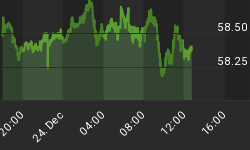If only we could dwell permanently in January, looking at December 2012 economic data, the U.S. would be a warm and sunny place. Today's Durable Goods number came in above expectations, although with revisions the ex-transportation figure was only slightly above forecasts. Again, though, this is a report for December, when incomes were higher due to the tax anticipation.
The December data is mostly finished, however, and now the January data begins to be reported. That starts with Consumer Confidence (Consensus: 64.0 from 65.1) on Tuesday. It can't happen soon enough for the bond market. The 10-year Treasury note touched 2% today, for the first time since last April; 10-year TIPS got above -0.60% for the first time since August (although, to be fair, 11bps of that is due to the roll, since the old 10-year TIPS are still at -0.69% which wouldn't even be the highest yield this month).
It is impressive to see the bond market selling off even though the Federal Reserve continues to buy. Partly, this may be because investors are fearful that the strong data will cause the Fed to stop buying, whereupon we all know we don't want to be overlong. That is unlikely to happen, certainly at this week's meeting. It is no mystery that December's numbers were pumped up by large distributions being made in 2012 over 2013, and the Fed would want to see (a) more strength than was evident even in December and (b) that strength maintained for a little while at least! And, of course, while the fiscal cliff can has been kicked down the road a couple of months, there is also still a debt ceiling debate that must be had in the next month or two. It seems unlikely that the Fed would stop buying Treasuries while those uncertainties still loom.
Over the last 18 months, the 10-year note has come up to the 2% level a number of times. Usually, that level has been pierced by 3-4bps before the market reversed again, but on two occasions yields went as high as 2.40%.
I think the top in bonds (lows in yield) have been reached, but I don't think the market will break to higher yields just yet. As I noted last week, I really don't want to be short bonds headed into the next week-plus of data.
Now, looking at a long-term chart the current set-up in 10-year yields is interesting. The chart below (Source: Bloomberg) is of monthly closing levels in 10-year yields, with the y-axis drawn with logarithmic scale. For years, I've always drawn the channel shown on the chart, such that it contained the entire bull market until the breakout around the time of the 2008 crisis.

A more common, but I think arguably less-correct way, is to draw the y-axis with a normal linear scale. In this case, the most-recent low actually makes a rare 6-point support trendline on the monthly closes. The channel is no longer truly a channel (the lines are not quite parallel), and the channel doesn't include the two 1980-1984 spikes, but it's a much prettier picture.

In either case, there is nothing to suggest that the secular downtrend in rates has yet become an uptrend. Someday, it will, because trees don't grow to the sky, and I wouldn't want to wait until 3.50% to start re-positioning (much less, the 4% implied by the log chart). But I don't think that day is here yet.
Now, while most people are still not afraid of inflation - which is the most-likely reason for nominal interest rates to eventually normalize - inflation swaps continue to rise. The 10-year inflation swap rate reached 2.80% today, about 10bps from the post-Lehman highs (see Chart, source Enduring Investments). Some people, evidently, are starting to be concerned.

Incidentally, some might be tempted to attribute today's inflation market rally the rise in unleaded gasoline futures. Unleaded rallied on news that Hess Corp (HES) is closing its NJ oil refining facility and its U.S. terminal network. However, this did not seem to translate into the inflation markets, as it often does - normally, the inflation swaps curve would flatten as the gasoline move has more relevance for a shorter inflation horizon, but today the front of the curve if anything underperformed after carry is taken into consideration. The rise in inflation swap quotes is deeper than this.
















